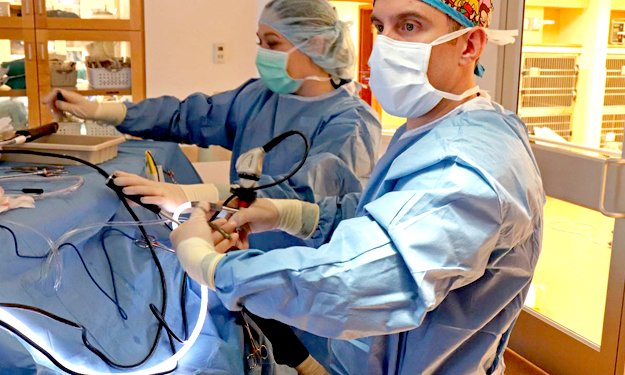Veterinary Arthroscopy: A Guide for Pet Owners

A short glossary of terms related to arthroscopic surgeries and conditions is below. This is by no means an exhaustive list, but it is a good place to start if your pet’s doctor has recommended that you visit a surgeon for joint disease in your pet. Additional content is linked throughout. We hope this resource will be helpful as you navigate the next steps in your pet’s orthopedic care.
- Arthroscopy: the use of miniature orthopedic cameras (endoscopy) and instruments to diagnose and treat joint diseases. Arthroscopy is a specific orthopedic form of endoscopy.
- Endoscopy the use of miniature cameras and instruments to diagnose and treat diseases throughout the body.
- Osteochondrosis Dissecans (OCD): a juvenile congenital cartilage disease where a small area of cartilage separates from the underlying bone leading to pain and lameness. OCD can usually be diagnosed with radiographs (X-rays) but should be treated arthroscopically. OCD occurs most commonly in the shoulder, elbow, knee, and hock. The prognosis depends upon the joint affected with the shoulder having the best prognosis. Early diagnosis and treatment is important to success. Arthroscopy is an outstanding method of diagnosis and treatment of OCD. Arthroscopy provides more accurate treatment with less pain and soft tissue disruption in comparison to traditional surgery.
- Elbow dysplasia: A group of congenital diseases of the elbow joint including
-
- Fragmented coronoid process/coronoid disease
- OCD (see above)
- Ununited anconeal process
- Medial compartment disease
- Incomplete ossification of the humeral condyle
Radiographic diagnosis of these diseases varies based on the specific disease and severity. Arthroscopy is an excellent means of diagnosis. Treatment depends also upon the specific disease and severity.
-
- Arthrocentesis: needle sampling of the fluid found in a joint
- Cruciate disease: similar to ACL disease in humans, the cranial cruciate ligament in dogs is highly prone to tearing. The cruciate ligament is NOT visible on radiographs (x-rays) although secondary signs of increased joint fluid and arthritis may be visible. Arthroscopy is an excellent method for the diagnosis of early tearing of the cruciate ligament.
- Meniscus: There are two meniscus in the knee joint. These may be torn in association with cruciate ligament injuries. The meniscus is not visible on radiographs. Arthroscopy is an outstanding method of diagnosis and treatment of meniscal tears with more accurate treatment and less pain and soft tissue disruption in comparison to traditional surgery.
- Biceps disease: The biceps muscle helps the shoulder and elbow of the front leg of dogs function. Tearing to the origin of the biceps muscle is common, particularly in sporting and hunting dogs. The biceps does not appear on radiographs but tears may be diagnosed by ultrasound with an experienced doctor. Biceps disease is easily diagnosed and treated with arthroscopy. In general, the prognosis following treatment of biceps disease is excellent.
- Fragmented coronoid process: The coronoid is a normal bone structure in the elbow joint of dogs. Diseases of the coronoid process are the most common form of elbow dysplasia and the most common cause of front leg lameness in dogs. Diseases of the coronoid process include:
- Fragmentation – a small 3mm – 5mm piece breaks off
- Osteonecrosis – a small area becomes soft
- Cartilage disease – the area loses the cartilage covering
- Ununited anconeal process: this is usually a disease of German shepherd dogs where a normal bone within the elbow joint becomes loose due to abnormal skeletal growth. This disease is usually diagnosed with radiography.
- Arthritis: most everyone is familiar with the concept of arthritis. This is usually associated with irreversible damage to the cartilage or other structures inside a joint. The end result is:
- Progressive cartilage damage
- New bone formation
- Joint inflammation and pain
- Muscle atrophy
- Loss of range of motion
- Septic arthritis: Infection of a joint by
- Bacteria
- Tick borne diseases
- Lyme
- Erllichia
- Anaplasmosis
- Fungal infection
- Suppurative arthritis: Increases in a specific cell type (neutrophils) in a joint, usually associated with infection or, less commonly, cancer
- Mononuclear inflammation: Increases in a specific cell type (mononuclear cells) usually associated with arthritis